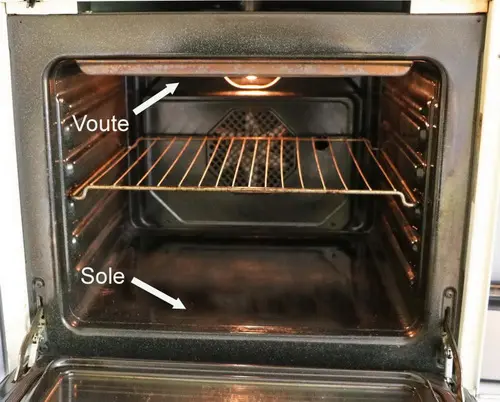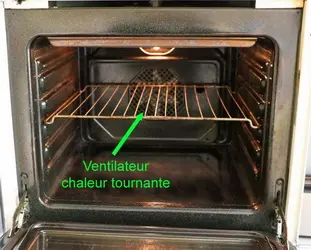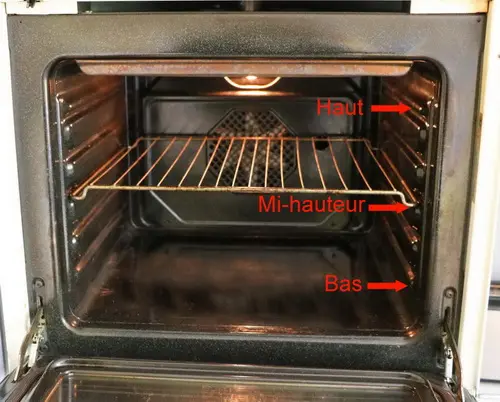Kitchen ovens

You certainly have one in your kitchen, an oven, the essential tool for all kinds of cooking, whether in the kitchen of course, but also in pastry, bakery, pizza, and many others.
Here is some information on its structure and operation.
Here is some information on its structure and operation.
34 K 4.4/5 (17 reviews)
Keywords for this post:OvenCookingTemperatureUseTipsLast modified on: May 16th 2020
Kitchen ovens
What is an oven?
It is a cooking method, as old as cooking, which consists in cooking food without direct contact with the heat source (as on a stove for example), but in a closed and heated enclosure.How does it work?
We are talking here about an electric oven, they are made of a square steel enclosure, thermally insulated, which closes with a tight door, often glazed.
The top of the oven is called "the vault" ("voute" in french), the bottom "the sole".
There is an electric resistance under the roof (often visible) and another one under the bottom (invisible), these two resistances when they receive electric current transform it into heat, it is what makes your oven heat up.
Normally one use the 2 resistors, to heat on the top and the bottom, but sometimes we need to heat only on the top, to make gratin, it is called the "grill" position, and in this case only the top resistor is heated and often at maximum power.
Here is the general principle: a closed and insulated enclosure, and 2 heating elements to heat the inside.
Improvements

More recently, there is also "pulsed heat", in this system the internal fan, which is always present, has its own heating resistor which delivers heated air, instead of stirring the air in the oven. Preheating and baking time is further reduced.
Lighting
ovens are lit, more or less well, and in the basic version, it's a simple small incandescent bulb (like a fridge lamp) that lights up the interior rather poorly. We have to admit that the lighting is rather average.The first improvement is that the lighting moves towards the vault, and is transformed with a halogen bulb. It's much more efficient.
The next improvement will see ovens equipped with leds, giving a powerful and regular light. This is already available at the time of writing (May 2020), but for the moment only in the higher end ovens.
The position in the oven

This position allows you to adjust a little where you want the heat to have the most effect:
- To put at the bottom, means that we want to insist on the bottom of the dish to cook it more (example a pie)
- Putting it on the top means that you want to put more heat on the top of the dish to cook it more (example a gratin)
- Putting it in the middle means that you want the dish to be cooked in a classic way, without any particularities.
What to choose?
There are many possibilities: rotating heat or not, position in the oven, temperature...Don't worry, with cooking-ez.com it's simple: if a special oven configuration is needed for a recipe it will be expressly indicated. And if not, always opt for "rotating heat" (if you have it) and position of the rack "halfway up".
Lasts posts
Butter vs. grease
We often read in a recipe where a pastry is put into a mould that, just before pouring, the mould should be buttered or greased. But what's the difference between these 2 terms?December 1st 20251,4235
Getting out of the fridge early
Very often when you're cooking, you need to take food or preparations out of the fridge, to use them in the recipe in progress. There's nothing tricky about this: you just take them out of the fridge and use them, usually immediately, in the recipe. But is this really a good method?November 24th 20251,2735
Who's making the croissants?
When you look at a bakery from the outside, you naturally think that in the bakery, the bakers make the bread, and in the laboratory, the pastry chefs make the cakes. It's very often like that, with each of these professions having quite different ways of working, but sometimes there's also one...November 23th 20251,164
Oven height
When we put a dish or cake in the oven, we naturally tend to put it on the middle shelf, and that's what we usually do. But in some cases, this position and height can be a little tricky, so let's find out why.October 8th 20253,2625
The importance of sieving
In recipes that use a fine powder (flour, powdered sugar, etc.), you'll often see the advice to sift before using it. To sift is to pass the powder in question through a sieve (a very fine strainer) before incorporating it into your recipe. It's often advice, but is it really useful?September 3rd 20257,8933
Other pages you may also like
The window-pane test in bread-making
The home bread-makers often ask themselves “Have I kneaded my dough long enough?” . A good question, as dough that is insufficiently kneaded will not rise properly or will fall flat when the top is slashed, which is very frustrating. To know when the dough is ready, one can rely on the length...June 16th 202197 K 23.9
What is the difference between bakery and patisserie?
This is a question that you may well have asked yourself and which I will attempt to answer. In France the two trades of "boulangerie" (bakery) and "pâtisserie" (patisserie and confectionery) have always been quite distinct, but where exactly do the boundaries lie? .February 7th 2017134 K 14.1
A few tips for effective kneading at home
When you have to knead dough for bread or some other recipe, you may well use a food processor or the type of machine known as a stand mixer. The best-known brands are Kenwood and KitchenAid. They are useful tools, but here are a few tips to help you get the best out of them.June 23th 2021284 K 23.8
Egg yolks and caster sugar
We often come across recipes where we need to mix egg yolks with caster sugar. This would appear to be a very ordinary and simple thing to do but, be warned, these two ingredients can behave oddly together.February 15th 201883 K 24.3
Fruits which can ruin your jelly
There are many ways of making a fruit mousse, but one of the simplest is to prepare a fruit jelly (basically a fresh fruit coulis with gelatine) and then mix this jelly before it sets completely with whipped cream. The result is perfect for filling a charlotte, for example. But do beware;...March 6th 201379 K4.0
Post a comment or question
Follow this page (as 3 people already do)
If you are interested in this page, you can "follow" it, by entering your email address here. You will then receive a notification immediately each time the page is modified or a new comment is added. Please note that you will need to confirm this following.
Note: We'll never share your e-mail address with anyone else.
Alternatively: you can subscribe to the mailing list of cooling-ez.com , you will receive a e-mail for each new recipe published on the site.









